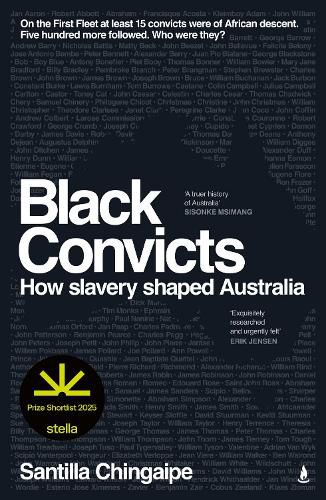Readings Newsletter
Become a Readings Member to make your shopping experience even easier.
Sign in or sign up for free!
You’re not far away from qualifying for FREE standard shipping within Australia
You’ve qualified for FREE standard shipping within Australia
The cart is loading…






Shortlisted for the 2025 Stella Prize
The story of Australia’s Black convicts has been all but erased from our history. In this deeply researched and illuminating book, Santilla Chingaipe offers a fresh understanding of this fatal shore, showing how empire, slavery, race and memory have shaped this nation.
On the First Fleet of 1788, at least 15 convicts were of African descent. By 1840 the number of Black transportees had risen to over 500. Among them were John Caesar, who became Australia’s first bushranger, and Billy Blue – the stylishly dressed ferryman who gave his name to Sydney’s Blues Point. There was also David Stuurman, a revered South African chief transported for anti-colonial insurrection, and William Cuffay – a prominent London Chartist who led the development of Australia’s labour movement. Two of the youngest were cousins from Mauritius – girls aged just 9 and 12 – sentenced over a failed attempt to poison their mistress.
But although some of these lives were documented and their likenesses depicted (including in the National Portrait Gallery and a sketch of those acquitted of treason after the Eureka stockade), their stories have been erased from history: even their descendants are often unaware of their ancestry.
In these stories spanning Africa, the Americas and Europe, Black Convicts also uncovers Australia’s hidden links to slavery, which both powered the British Empire and inspired the convict system itself. Situating European settlement in its global context, Chingaipe shows the injustice of dispossession was powered by the engine of labour exploitation.
By uncovering lives whitewashed out of our story, Black Convicts will change the way we think about who we are.
$9.00 standard shipping within Australia
FREE standard shipping within Australia for orders over $100.00
Express & International shipping calculated at checkout
Shortlisted for the 2025 Stella Prize
The story of Australia’s Black convicts has been all but erased from our history. In this deeply researched and illuminating book, Santilla Chingaipe offers a fresh understanding of this fatal shore, showing how empire, slavery, race and memory have shaped this nation.
On the First Fleet of 1788, at least 15 convicts were of African descent. By 1840 the number of Black transportees had risen to over 500. Among them were John Caesar, who became Australia’s first bushranger, and Billy Blue – the stylishly dressed ferryman who gave his name to Sydney’s Blues Point. There was also David Stuurman, a revered South African chief transported for anti-colonial insurrection, and William Cuffay – a prominent London Chartist who led the development of Australia’s labour movement. Two of the youngest were cousins from Mauritius – girls aged just 9 and 12 – sentenced over a failed attempt to poison their mistress.
But although some of these lives were documented and their likenesses depicted (including in the National Portrait Gallery and a sketch of those acquitted of treason after the Eureka stockade), their stories have been erased from history: even their descendants are often unaware of their ancestry.
In these stories spanning Africa, the Americas and Europe, Black Convicts also uncovers Australia’s hidden links to slavery, which both powered the British Empire and inspired the convict system itself. Situating European settlement in its global context, Chingaipe shows the injustice of dispossession was powered by the engine of labour exploitation.
By uncovering lives whitewashed out of our story, Black Convicts will change the way we think about who we are.
The history of slavery in Australia is a history that has been largely silenced. In 2020, then-Prime Minister Scott Morrison went as far as to claim that ‘there was no slavery in Australia’. In Black Convicts, Santilla Chingaipe problematises this view, showing how Australia was built on not just the work of Black convicts and slaves, but also enslavers. This is the history that we as a nation inherit.
Chingaipe takes us through a history of British slavery pre-Australian colonisation, highlighting that by the time Britain reached these shores, slavery was already entrenched in the British economy and ideology. Enslaved or formerly enslaved African people sometimes came to Britain, and from there, some came to Australia on the First Fleet. Other African convicts came to Australia in the years to come. Very occasionally, Black people of African descent arrived in Australia as free people.
As far as the archives allow, Chingaipe considers the lives of individual Black convicts in Australia. They are not simply history, but people. However, especially in the days of early colonisation, information is limited. That the archives aren’t neutral is forefront of this work. Black Convicts engages not just with history, but also with historiography. What kind of stories do we tell when we tell history? And what kind of stories do we not tell, do we hide, do we erase? What kind of stories are we ignorant of? Chingaipe gives us no excuse to be ignorant of this one – the history of Black convicts and slaves in Australia is finally visible, and essential reading for all.
See what the Readings’ team have to say on the blog, discover related events and podcast episodes.
The shortlist for the 2025 Stella Prize has been announced! Discover these great Australian works of fiction and nonfiction with 20% off RRP when ordering online! Just enter the code STELLA25 at checkout to receive the discount!
This offer is only available online, while stocks last, until 11:59pm on Thursday 22 May.
Offering a wealth of history across the ages, the books in this collection focus on female authors.
Before you see them at the festival, pickup these insightful works of nonfiction from the guests of the 2025 Melbourne Writers Festival – a cosmic combination of local and international writers!